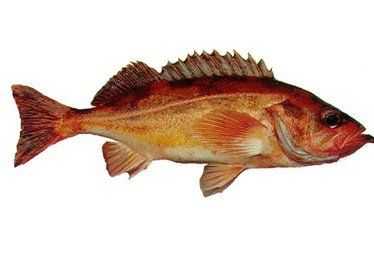Redstripe Rockfish

Species Details
Sebastes Proriger
Sebastidae
Scorpaeniformes
Offshore, Deepwater
1 - 1 lbs.
13" - 24"
Redstripe Rockfish (Sebastes Proriger) Fish Description
The redstripe rockfish appears as light red or pink, with gradients of olive-brown on the top and yellow on the underside. Its lateral line is conspicuous, light red, and bordered by olive-green mottling. There are also greenish stripes around its eye that spread towards its face. The anterior part of the lips is slightly blackened, with a protruding lower jaw that has a long and prominent symphyseal knob.
It has 13 dorsal spines with 13-15 dorsal rays, with a shallow notch towards the tail posterior. It has paired pectoral fins. Its fins are red with a light green or yellow tinge. The tail is slightly indented and may have dark streaks on the tip.
Diet & Size
The redstripe rockfish is a small fish normally around 13 inches long but reaches up to 20 inches in length. The IGFA All-Tackle world record is currently at 1 lb 4 oz caught in Alaska in 2019.
The redstripe rockfish directly competes with widow rockfish and canary rockfish for food and territory. They primarily feed on copepods as juveniles and shift to crustaceans, forage fish, and cephalopods as adults.
Interesting facts about the Redstripe Rockfish
- Redstripe rockfish can live up to 55 years
- Masters at hovering in mid-water without moving
- The redstripe rockfish is viviparous and gives birth to live young
- Rockfish are called such because they like to hide among rocks
- They are flavorful with a light flaky flesh that can be prepared in numerous ways
Fishing Techniques: How to Catch a Redstripe Rockfish
The redstripe rockfish is not a popular game fish because the specimens suffer barotrauma after being set back into the water. This would require anglers to use a descending device, which helps return the fish to deep waters and increases its chances of survival.
If fishing for them, targeting offshore schools will yield higher chances of hooking a redstripe rockfish. Casting rubber tail jigs or shrimp flies in the aggregation will most likely catch a rockfish and they do not put up much of a fight.
Both bait and artificial lures while drift fishing will work, such as strips of squid, scampi tails, bucktail, or octopus-type lures. However, the key is to make sure your line sinks to the bottom quickly. Using a metal jig or a diamond jig can help you yield bigger fish in deeper waters or if the currents are strong.
Any conventional saltwater reel or spinning tackle with a braided line will work in deeper waters with the redstripe rockfish. If targeting in shallower waters (which most anglers say provides better sport), a light baitcasting or spinning reel will provide a better challenge.
Redstripe Rockfish Habitat & Distribution
The redstripe rockfish is commonly found at depths of 500-900 feet but can go up to 1,300 deep and as shallow as 70 feet. It is a deepshore benthic fish that prefers rocky reefs and steep sediment-covered drop-offs. It may be observed hovering slightly off rugged bottoms, and are often populous in schools near the upper regions of the continental shelf during the day that thin out at night.
They are found throughout the North Pacific from Pribilof Canyon in the Bering Sea, Amchitka Island in the Aleutian chain in Alaska, to southern Baja California. In British Columbia, they are abundant near Hecate Strait, Goose Island, and Mitchell’s Gullies of Queen Charlotte Sound.
Spawning occurs from May to July and the fertilized eggs stay inside the ovary until the larvae exit. They may gather their initial nutrition from the female parent during early development.
The redstripe rockfish is highly sensitive to climate change caused by the warming waters that affect the abundance of their prey. The lack of a food base lessens the survival rate of juveniles and the fertility of adults.
Rising sea levels affect the nearshore habitats that juveniles use as a foraging zone as well, and decreasing deepwater corals also affect adult survival. However, the long life span of the redstripe rockfish has allowed it to persist throughout these environmental challenges, but low fertility rates could mean population decline.
The California Department of Wildlife and Fisheries has listed the redstripe rockfish as a Species of Greatest Conservation Need. It is also identified as a priority species under the Priority Habitat and Species Program, meaning it’s required to be protected to ensure healthy population numbers.







